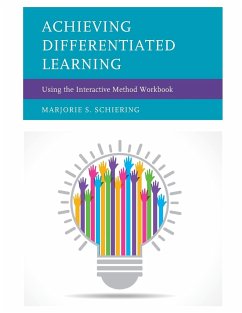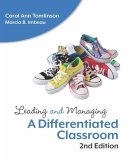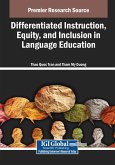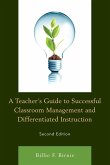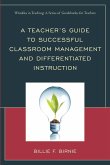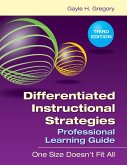- Broschiertes Buch
- Merkliste
- Auf die Merkliste
- Bewerten Bewerten
- Teilen
- Produkt teilen
- Produkterinnerung
- Produkterinnerung
This book is primarily for teachers of student learners with special needs, different abilities or who require a methodology for retention of curriculum and are at any grade, age level.
Andere Kunden interessierten sich auch für
![Achieving Differentiated Learning Achieving Differentiated Learning]() Marjorie S. SchieringAchieving Differentiated Learning73,99 €
Marjorie S. SchieringAchieving Differentiated Learning73,99 €![Leading and Managing a Differentiated Classroom Leading and Managing a Differentiated Classroom]() Carol Ann TomlinsonLeading and Managing a Differentiated Classroom30,99 €
Carol Ann TomlinsonLeading and Managing a Differentiated Classroom30,99 €![Differentiated Instruction, Equity, and Inclusion in Language Education Differentiated Instruction, Equity, and Inclusion in Language Education]() Differentiated Instruction, Equity, and Inclusion in Language Education165,99 €
Differentiated Instruction, Equity, and Inclusion in Language Education165,99 €![Differentiated Instruction, Equity, and Inclusion in Language Education Differentiated Instruction, Equity, and Inclusion in Language Education]() Differentiated Instruction, Equity, and Inclusion in Language Education214,99 €
Differentiated Instruction, Equity, and Inclusion in Language Education214,99 €![Teacher's Guide to Successful Classroom Management and Differentiated Instruction Teacher's Guide to Successful Classroom Management and Differentiated Instruction]() Billie F. BirnieTeacher's Guide to Successful Classroom Management and Differentiated Instruction23,99 €
Billie F. BirnieTeacher's Guide to Successful Classroom Management and Differentiated Instruction23,99 €![Teacher's Guide to Successful Classroom Management and Differentiated Instruction Teacher's Guide to Successful Classroom Management and Differentiated Instruction]() Billie F. BirnieTeacher's Guide to Successful Classroom Management and Differentiated Instruction21,99 €
Billie F. BirnieTeacher's Guide to Successful Classroom Management and Differentiated Instruction21,99 €![Differentiated Instructional Strategies Professional Learning Guide Differentiated Instructional Strategies Professional Learning Guide]() Gayle H. GregoryDifferentiated Instructional Strategies Professional Learning Guide35,99 €
Gayle H. GregoryDifferentiated Instructional Strategies Professional Learning Guide35,99 €-
-
-
This book is primarily for teachers of student learners with special needs, different abilities or who require a methodology for retention of curriculum and are at any grade, age level.
Produktdetails
- Produktdetails
- Verlag: Rowman & Littlefield Publishers
- Seitenzahl: 124
- Erscheinungstermin: 26. Juli 2019
- Englisch
- Abmessung: 280mm x 216mm x 7mm
- Gewicht: 334g
- ISBN-13: 9781475831740
- ISBN-10: 1475831749
- Artikelnr.: 55480669
- Herstellerkennzeichnung
- Libri GmbH
- Europaallee 1
- 36244 Bad Hersfeld
- gpsr@libri.de
- Verlag: Rowman & Littlefield Publishers
- Seitenzahl: 124
- Erscheinungstermin: 26. Juli 2019
- Englisch
- Abmessung: 280mm x 216mm x 7mm
- Gewicht: 334g
- ISBN-13: 9781475831740
- ISBN-10: 1475831749
- Artikelnr.: 55480669
- Herstellerkennzeichnung
- Libri GmbH
- Europaallee 1
- 36244 Bad Hersfeld
- gpsr@libri.de
Marjorie S. Schiering' has taught first, third, fifth, sixth, undergraduate, and graduate courses for five decades. She is an international presenter and children's book author. She has written seven textbooks, continually weaving in teaching creativity, using interactive methods, and means for being a person of good character. She teaches with an emphasis on students realizing their academic success, increasing their desire to learn, and meeting their academic and socialization needs.
Prelude
Foreword
Preface
Acknowledgments
Introduction
Part One: Explaining the interactive method (IM) regarding thinking skills,
memory, and classroom implementation
Chapter One: Explaining The Interactive Method (IM): Experience-based
Teaching and Learning
Chapter Two: Reciprocal Thinking, Cognitive Collective and Memories The
Teaching of Thinking
Chapter Three: Addressing "Different Ways" through Assignments,
Requirements, and Purposes
Part two: different learners = different ways: the "how to" of the "IM"
Chapter Four: Six Specific Types of Differention: Explanation and Example
Chapter Five: Different Ways with 25- Examples
Chapter Six: Different Ways with 28-Examples
Chapter Seven: Different Ways with 13- Examples, Including Technology
Chapter Eight: Activity-based Learning Centers/ABLC: 6-Tri-fold Boards
Chapter Nine: Graphic Organizers/Text Structures and Four Interactive
Instructional Resources: Directions and Application
Part three: personal commentaries on special needs and different abilities
+ author's closing thoughts
Chapter Ten: Personal Perspectives Regarding Parenting and/or Teaching
Different Abilities and Special Needs Students
Perspectives on a Learner's Dyslexia: Patricia Eckardt
From the Heart: Having Different Abilities Children: Their Dad's Narrative:
Timothy Ryley
Teaching Special Education Technology: Clare King
Chapter Eleven: author's closing thoughts
References
About the author
Foreword
Preface
Acknowledgments
Introduction
Part One: Explaining the interactive method (IM) regarding thinking skills,
memory, and classroom implementation
Chapter One: Explaining The Interactive Method (IM): Experience-based
Teaching and Learning
Chapter Two: Reciprocal Thinking, Cognitive Collective and Memories The
Teaching of Thinking
Chapter Three: Addressing "Different Ways" through Assignments,
Requirements, and Purposes
Part two: different learners = different ways: the "how to" of the "IM"
Chapter Four: Six Specific Types of Differention: Explanation and Example
Chapter Five: Different Ways with 25- Examples
Chapter Six: Different Ways with 28-Examples
Chapter Seven: Different Ways with 13- Examples, Including Technology
Chapter Eight: Activity-based Learning Centers/ABLC: 6-Tri-fold Boards
Chapter Nine: Graphic Organizers/Text Structures and Four Interactive
Instructional Resources: Directions and Application
Part three: personal commentaries on special needs and different abilities
+ author's closing thoughts
Chapter Ten: Personal Perspectives Regarding Parenting and/or Teaching
Different Abilities and Special Needs Students
Perspectives on a Learner's Dyslexia: Patricia Eckardt
From the Heart: Having Different Abilities Children: Their Dad's Narrative:
Timothy Ryley
Teaching Special Education Technology: Clare King
Chapter Eleven: author's closing thoughts
References
About the author
Prelude
Foreword
Preface
Acknowledgments
Introduction
Part One: Explaining the interactive method (IM) regarding thinking skills,
memory, and classroom implementation
Chapter One: Explaining The Interactive Method (IM): Experience-based
Teaching and Learning
Chapter Two: Reciprocal Thinking, Cognitive Collective and Memories The
Teaching of Thinking
Chapter Three: Addressing "Different Ways" through Assignments,
Requirements, and Purposes
Part two: different learners = different ways: the "how to" of the "IM"
Chapter Four: Six Specific Types of Differention: Explanation and Example
Chapter Five: Different Ways with 25- Examples
Chapter Six: Different Ways with 28-Examples
Chapter Seven: Different Ways with 13- Examples, Including Technology
Chapter Eight: Activity-based Learning Centers/ABLC: 6-Tri-fold Boards
Chapter Nine: Graphic Organizers/Text Structures and Four Interactive
Instructional Resources: Directions and Application
Part three: personal commentaries on special needs and different abilities
+ author's closing thoughts
Chapter Ten: Personal Perspectives Regarding Parenting and/or Teaching
Different Abilities and Special Needs Students
Perspectives on a Learner's Dyslexia: Patricia Eckardt
From the Heart: Having Different Abilities Children: Their Dad's Narrative:
Timothy Ryley
Teaching Special Education Technology: Clare King
Chapter Eleven: author's closing thoughts
References
About the author
Foreword
Preface
Acknowledgments
Introduction
Part One: Explaining the interactive method (IM) regarding thinking skills,
memory, and classroom implementation
Chapter One: Explaining The Interactive Method (IM): Experience-based
Teaching and Learning
Chapter Two: Reciprocal Thinking, Cognitive Collective and Memories The
Teaching of Thinking
Chapter Three: Addressing "Different Ways" through Assignments,
Requirements, and Purposes
Part two: different learners = different ways: the "how to" of the "IM"
Chapter Four: Six Specific Types of Differention: Explanation and Example
Chapter Five: Different Ways with 25- Examples
Chapter Six: Different Ways with 28-Examples
Chapter Seven: Different Ways with 13- Examples, Including Technology
Chapter Eight: Activity-based Learning Centers/ABLC: 6-Tri-fold Boards
Chapter Nine: Graphic Organizers/Text Structures and Four Interactive
Instructional Resources: Directions and Application
Part three: personal commentaries on special needs and different abilities
+ author's closing thoughts
Chapter Ten: Personal Perspectives Regarding Parenting and/or Teaching
Different Abilities and Special Needs Students
Perspectives on a Learner's Dyslexia: Patricia Eckardt
From the Heart: Having Different Abilities Children: Their Dad's Narrative:
Timothy Ryley
Teaching Special Education Technology: Clare King
Chapter Eleven: author's closing thoughts
References
About the author

